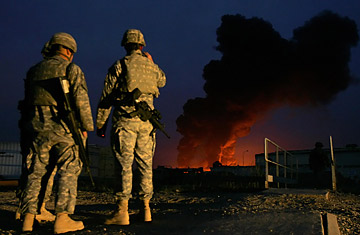
U.S. soldiers on patrol in Mahmudiya in 2005
Part 5 of TIME's Return to Baghdad series.
Our trip out of the city took us into the area once known as the Triangle of Death, a swath of farmland between three towns south of Baghdad. The area took its name from the fierce insurgency and terrain that favors the guerrilla fighter. Soft dirt roads were often riddled with buried bombs and after launching their attacks, insurgents could escape into the canal systems that punctuate seemingly flat fields.
Soon after the city receded into the dusty but green land, I began counting the palm groves and the highway overpasses from the area I patrolled in 2006. After the third overpass, I saw the landmark I was looking for — the short bridge over a canal that was the site where I was first ambushed.
My welcome to combat came during the very first patrol I led on my own. On a cold January night, I was in charge of a section of two Bradley fighting vehicles guarding the highway. We crossed over the canal bridge and suddenly drove into a wall of machine gun fire. I ordered my driver to push forward to get a better angle on the attackers when an insurgent peeked over a mound of dirt and fired a rocket-propelled grenade at the back of my Bradley.
The rocket skimmed the back of the vehicle and exploded into the wall of a nearby Iraqi army compound. The entire fight lasted less than two minutes: they shot at us; we shot at them. They ducked into the canal system and we were powerless to chase them. When I returned to the base the following morning, I wrote in my journal that Teddy Roosevelt, whose biography I had recently finished, would have considered it a rather sporty engagement.
Over the next few months, that gun battle fell away in our memory as larger and deadlier ones took its place. But for all of our dangers, nothing we saw was as bad as what we heard coming out of Mahmudiya. Our friends who patrolled the volatile city told horror stories of driving down roads and hitting a roadside bomb. As they rushed to evacuate the casualties, they hit several more bombs planted behind them as they worked to save their wounded.
One of the grizzliest stories I heard from the place came after two soldiers from the 101st Airborne were captured outside of the city. When their bodies were discovered lashed against a tree, one of my best friends led a unit of engineers to clear the road to their remains. His platoon had to fight their way through multiple burried bombs, then dismantle a booby trap that had been rigged on the soldiers' mangled bodies.
Now, as Bobby Ghosh and I drove through the final checkpoint into Mahmudiya, my first thought was that I knew quite a few people that had died here. An hour later, the head of Mahmudiya's city council told us that, for all of the city's problems — lack of water, high unemployment — the security situation was relatively stable. He insisted that there have been few attacks in recent months and that Mahmudiya had come a long way from its tortured past.
From the council office, we embarked on what passes for an embed with the Iraqi army. Our small group strolled through a market that was teeming with merchants selling furniture, trinkets and WWE wrestling cards as Iraqi soldiers secured our way. We didn't stay long. As patrols go, it may have been the shortest of my career, but given the history of the place, perhaps that is a good thing.
